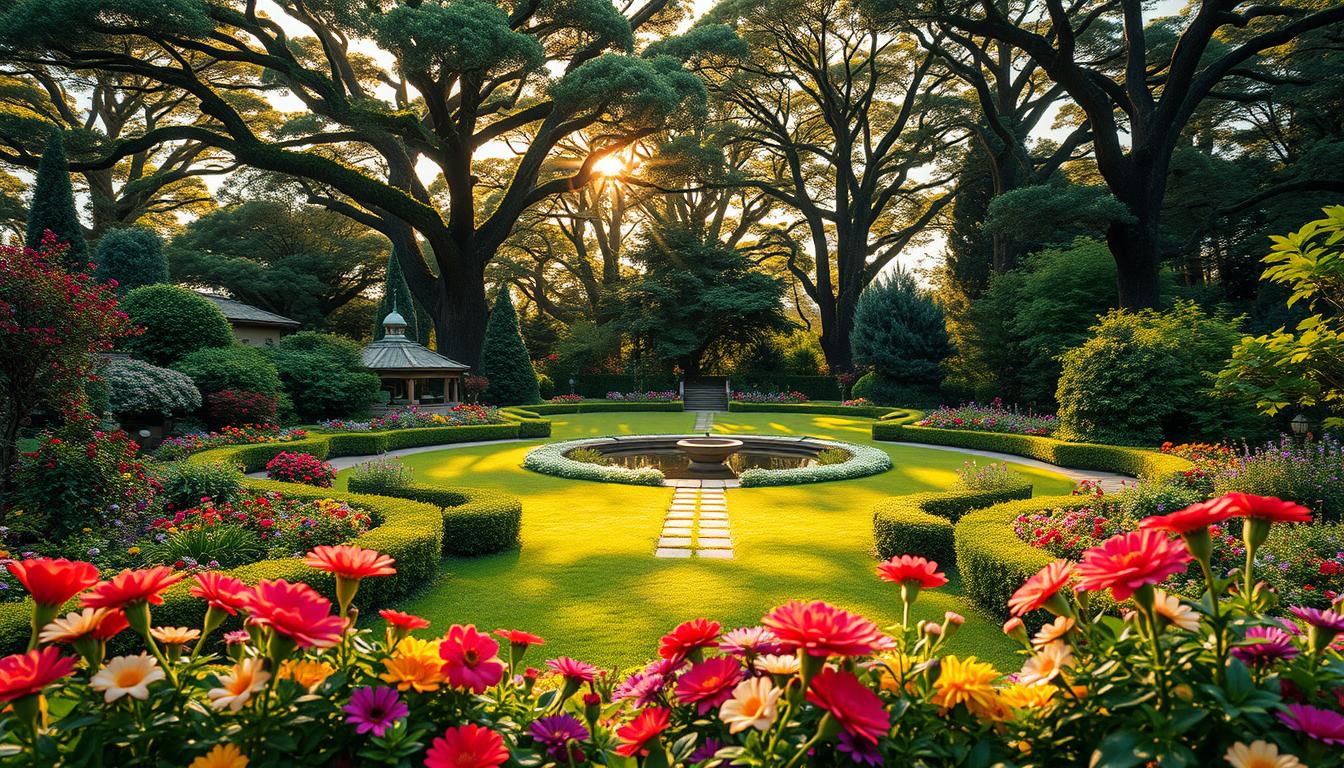Creating a thriving outdoor space starts with thoughtful design. Whether you’re a beginner or an experienced gardener, a well-structured garden plan ensures success. It saves time, money, and effort in the long run.
Assessing your space is the first step. Consider factors like sunlight, soil quality, and microclimates. These elements influence which plants will thrive. Experts from Gardenary and RHS emphasize the importance of adaptability, especially for urban or rural settings.
Sustainable practices also play a key role. From water conservation to native plant selection, every detail matters. A well-thought-out layout not only enhances beauty but also supports the ecosystem.
Key Takeaways
- Strategic planning saves time, money, and effort.
- Assess space, sunlight, and soil for optimal results.
- Choose plants suited to your garden’s microclimate.
- Incorporate sustainable practices for long-term benefits.
- Adapt designs for urban or rural spaces.
Why You Need a Garden Plan
Starting with a clear strategy transforms your green space. Without a thoughtful approach, common pitfalls like dead plants and wasted resources can quickly derail your efforts. For example, a friend once tried growing lavender on their balcony without considering sunlight needs. The result? A failed attempt and wasted time.
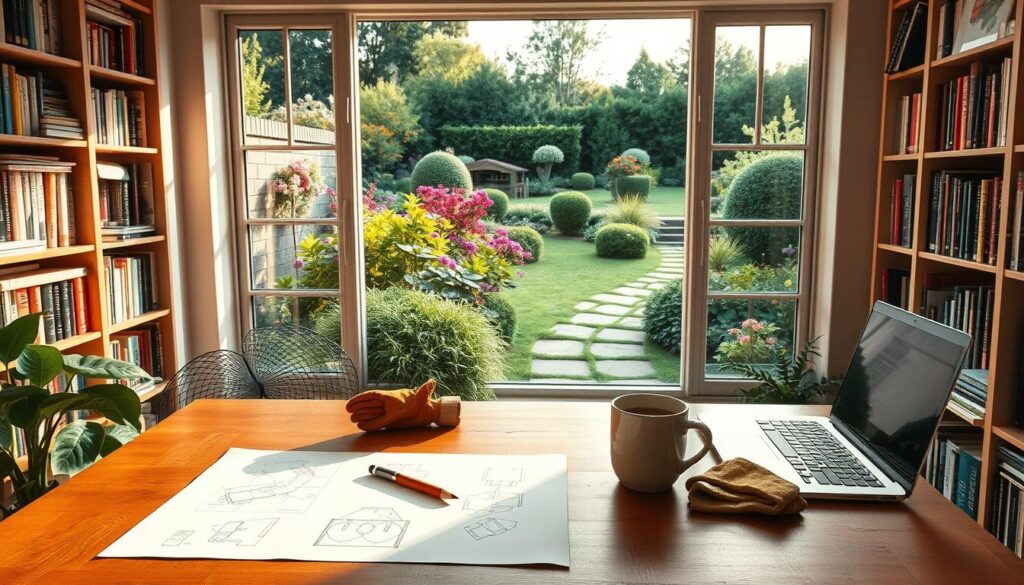
Planning prevents overcrowding and mismatched plant needs. It ensures each plant has the right conditions to thrive. This thoughtful design also supports seasonal interest, keeping your space vibrant year-round.
Long-term benefits include reduced maintenance and support for local wildlife. By avoiding trial-and-error, you save money and effort. A well-organized garden is not only beautiful but also sustainable.
For beginners, starting with a structured approach is key. It simplifies the process and sets you up for success. Whether you’re working with a small balcony or a sprawling yard, planning makes all the difference.
How to Make a Garden Plan: Step-by-Step
Crafting a successful outdoor area begins with understanding your space. Whether you’re working with a small balcony or a large yard, assessing your garden space is essential. This step ensures your design aligns with the natural features of your area.
Assess Your Garden Space
Start by measuring the size of your outdoor spot. Create rough sketches to visualize the layout. For example, an L-shaped garden can maximize planting areas while leaving room for pathways.
Use smartphone compass apps to determine the aspect of your space. A north-facing spot may receive less sunlight, while a south-facing one could be ideal for sun-loving plants. Identifying microclimates, like sunny patios or shaded corners, helps you choose the right greenery.
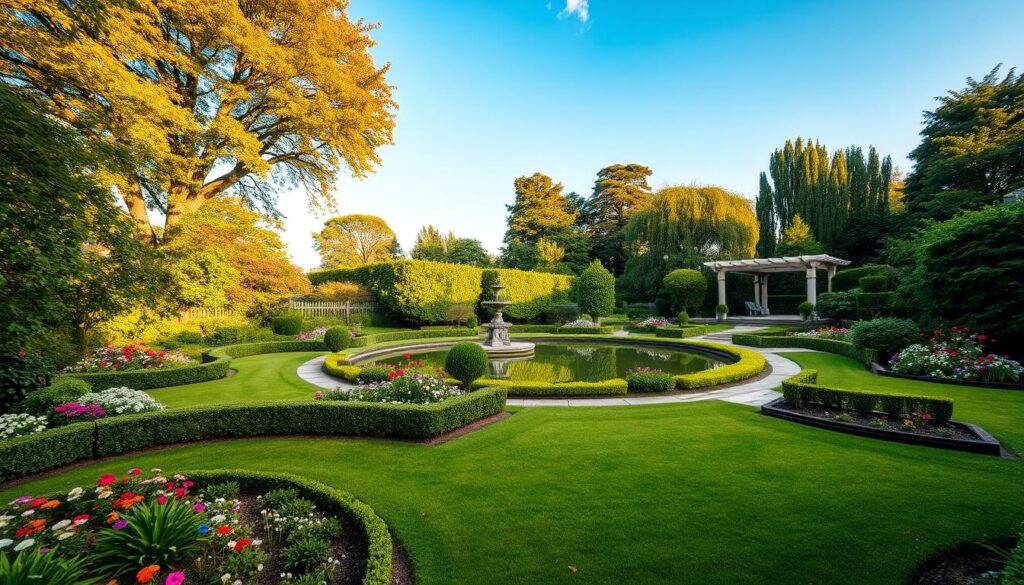
Determine Your Garden Goals
Set realistic goals based on your needs. Are you aiming for food production, aesthetic appeal, or a child-friendly environment? Each goal influences the choice of plants and features.
Consider multi-year planning for perennial growth. Your garden space can evolve over time, accommodating new ideas and changing preferences. This approach ensures long-term success and satisfaction.
Understanding Your Garden’s Microclimate
Your garden’s success hinges on understanding its unique microclimate. This includes factors like sunlight, wind, and temperature variations. These elements influence which plants will thrive in your space.
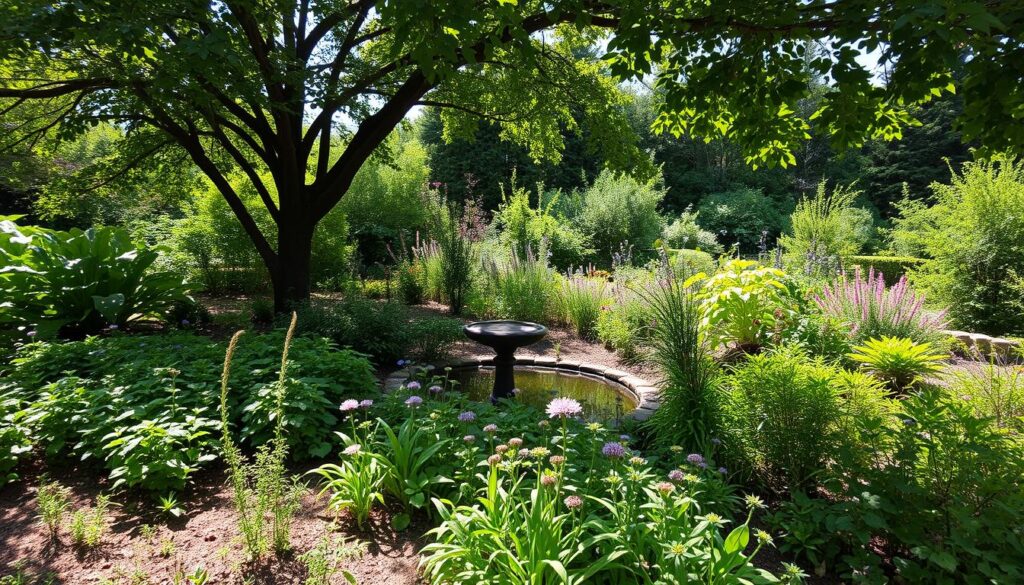
Microclimates can vary even within a small area. A sunny spot might be perfect for tomatoes, while a shaded corner could suit ferns. Recognizing these differences ensures your garden flourishes year-round.
Track the Sun’s Movement
Sunlight is a critical factor in plant growth. Use timelapse observations to document sunlight patterns across seasons. This helps you identify the best spots for sun-loving plants.
Second Source’s shadow mapping technique is a great tool. It involves marking shadows at different times of the day. This method reveals how sunlight interacts with your garden throughout the year.
Identify Windy and Sheltered Areas
Wind exposure varies based on location. Coastal areas often experience strong winds, while urban spaces may have more sheltered zones. Understanding this helps you choose the right plants.
Frost pockets and heat retention are also important. Sheltered spots can retain warmth, while low-lying areas may trap cold air. Plan accordingly to protect sensitive plants.
“Windbreaks like hedges or trellises can shield your garden from harsh winds, creating a more stable environment for growth.”
| Microclimate Factor | Impact on Garden | Solution |
|---|---|---|
| Sunlight | Determines plant placement | Use shadow mapping |
| Wind | Affects plant health | Install windbreaks |
| Frost Pockets | Can damage sensitive plants | Choose sheltered spots |
Designing Your Garden Layout
A well-organized outdoor space begins with a clear vision and strategic layout. This step ensures your design is both functional and visually appealing. Start by sketching your ideas to bring your vision to life.
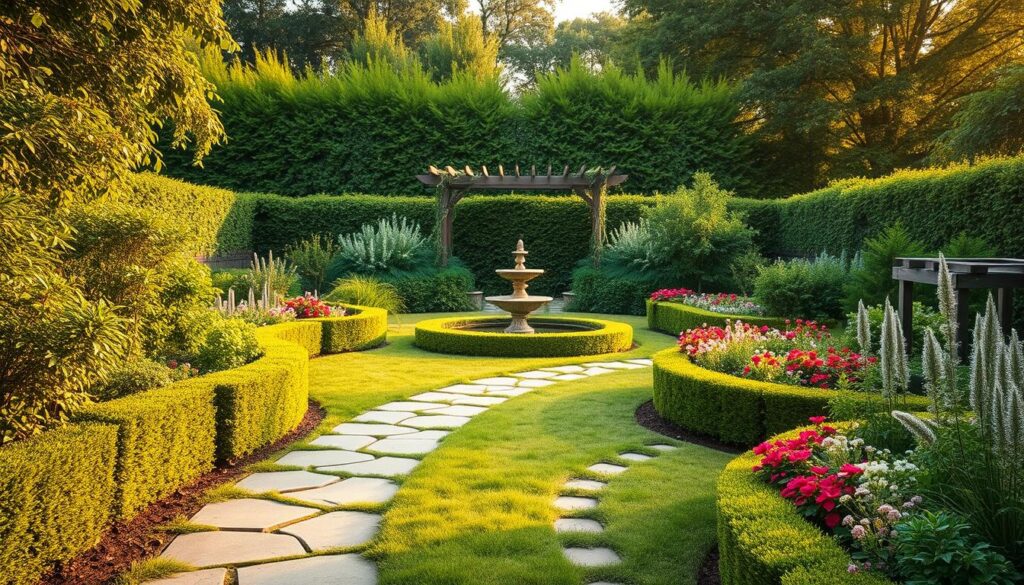
Sketch Your Garden Plan
Begin by mapping out your garden on grid paper or using digital tools. Scale drawings help you visualize the space accurately. Include key elements like beds, pathways, and water sources.
Consider the “garden rooms” concept from Second Source. This approach divides your space into functional areas, such as a sunny patio or a play area. It adds structure and purpose to your design.
Create Garden Zones
Divide your garden into zones based on usage and plant needs. For example, place high-maintenance veggies in one area and ornamental beds in another. This separation simplifies care and enhances aesthetics.
Pathways should be at least 3 feet wide for accessibility. Position water sources and tool storage strategically to save time and effort. Here are some zoning ideas:
- Potting area for seedlings and tools
- Family seating for relaxation
- Veg patch for fresh produce
By organizing your garden into zones, you create a harmonious and efficient outdoor space. This thoughtful layout ensures every corner serves a purpose.
Choosing the Right Plants for Your Garden
Selecting the perfect plants transforms your outdoor space into a vibrant sanctuary. The key lies in understanding your garden’s unique conditions and aligning them with the right greenery. From soil quality to seasonal changes, every detail matters.
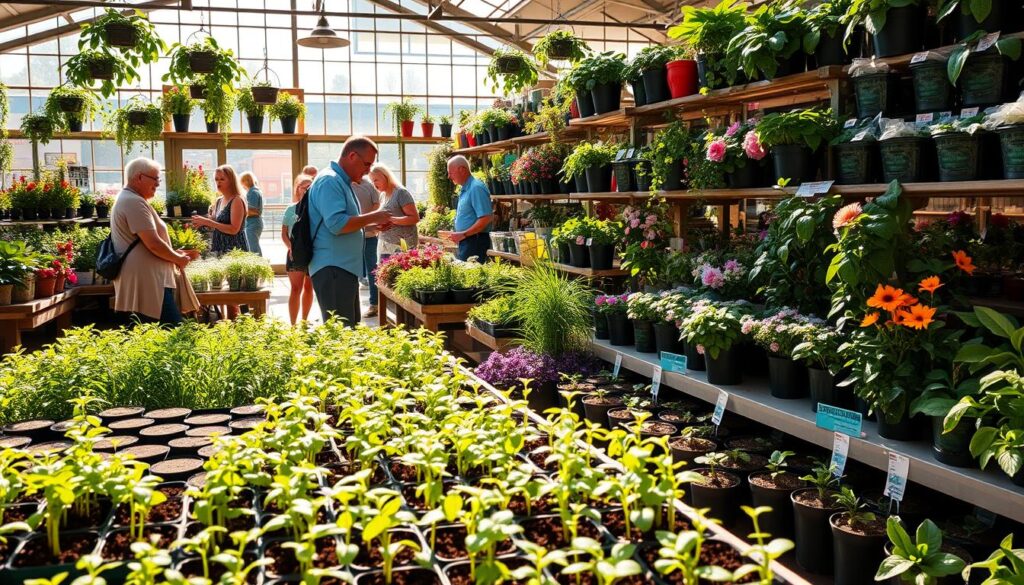
Consider Soil Type and pH
Your garden’s soil plays a crucial role in plant health. Conducting a soil test using RHS methods helps you determine its type and pH level. For example, lavender thrives in alkaline soil, while blueberries prefer acidic conditions.
Matching plants to your soil ensures they flourish. If your soil is clay-heavy, opt for shrubs like hydrangeas. Sandy soil? Consider drought-tolerant species like succulents. Tailoring your choices to the soil type maximizes growth and reduces maintenance.
Plan for Seasonal Interest
Creating year-round beauty requires thoughtful planning. Use succession planting to maintain color and texture across seasons. Start with spring bulbs, transition to summer annuals, and finish with autumn foliage.
Third Source highlights examples like winter bark textures and pollinator mixes. These additions ensure your garden remains lively even in colder months. For small spaces, dwarf fruit trees are a fantastic option, offering both beauty and functionality.
“A well-planned garden evolves with the seasons, offering continuous delight and supporting local wildlife.”
- Test your soil to determine its type and pH.
- Choose plants suited to your garden’s conditions.
- Incorporate shrubs and trees for structure and shade.
- Use succession planting for year-round color and interest.
- Explore Third Source examples like pollinator mixes and winter textures.
Incorporating Structures and Features
Elevate your outdoor area by integrating functional and aesthetic elements. Structures like trellises and water features not only enhance the design but also maximize your space. These additions create a dynamic environment that supports both beauty and practicality.

Using Trellises for Vertical Gardening
A trellis is a game-changer for small spaces. It allows you to grow plants vertically, freeing up ground area for other uses. First Source highlights how trellises improve air circulation, reducing the risk of disease for crops like cucumbers and tomatoes.
Training plants to climb a trellis also makes harvesting easier. This method is ideal for urban settings where horizontal space is limited. Plus, it adds a striking visual element to your outdoor area.
Adding Water Features and Ponds
Water features, such as ponds or whiskey barrel fountains, bring tranquility to your design. Third Source recommends self-cleaning systems for low-maintenance options. These features not only enhance aesthetics but also attract wildlife like birds and butterflies.
When adding a water feature, consider safety measures, especially for families with children. Position it in a visible area and use shallow designs to minimize risks. A well-placed pond or fountain can become the centerpiece of your outdoor space.
“A thoughtfully placed trellis or water feature transforms your garden into a multi-dimensional retreat.”
- Maximize vertical space with trellises for climbing plants.
- Train vegetables like cucumbers to grow vertically for better air circulation.
- Install self-cleaning pond systems for easy maintenance.
- Use water features to attract wildlife while ensuring safety.
- Position arbors or trellises to optimize shade and aesthetics.
Planning for Wildlife and Sustainability
Transforming your outdoor space into a haven for wildlife and sustainability begins with thoughtful choices. By incorporating eco-friendly practices and selecting the right plants, you can create a thriving ecosystem that supports local life.

Choose Wildlife-Friendly Plants
Selecting native plants is a simple yet impactful way to support wildlife. Species like milkweed attract monarch butterflies, while clover lawns provide food for bees. Avoid pesticides and opt for companion planting to naturally deter pests.
Second Source advocates replacing artificial turf with clover lawns. This not only benefits pollinators but also reduces plastic waste. Creating habitats like hedgehog highways and bee hotels further enhances your garden’s biodiversity.
Incorporate Sustainable Practices
Sustainability goes beyond plant selection. Install rainwater harvesting systems to conserve water, as recommended by Second Source. This reduces reliance on municipal supplies and supports your garden during dry spells.
Third Source highlights the importance of pollinator-friendly designs. Planting a mix of flowering species ensures year-round food sources for bees and butterflies. Small changes, like avoiding synthetic fertilizers, can have a big impact on the environment.
“A sustainable garden nurtures both nature and the human spirit, creating a space where life thrives in harmony.”
- Plant native species to support local wildlife.
- Install rainwater systems to conserve water.
- Replace artificial turf with eco-friendly alternatives.
- Create habitats like bee hotels and hedgehog highways.
- Use companion planting to reduce pesticide use.
Preparing Your Garden for Planting
Getting your outdoor space ready for planting ensures a strong start for your greenery. Proper preparation lays the foundation for healthy growth and minimizes future challenges. Focus on enhancing your soil and setting up efficient systems to support your plants.
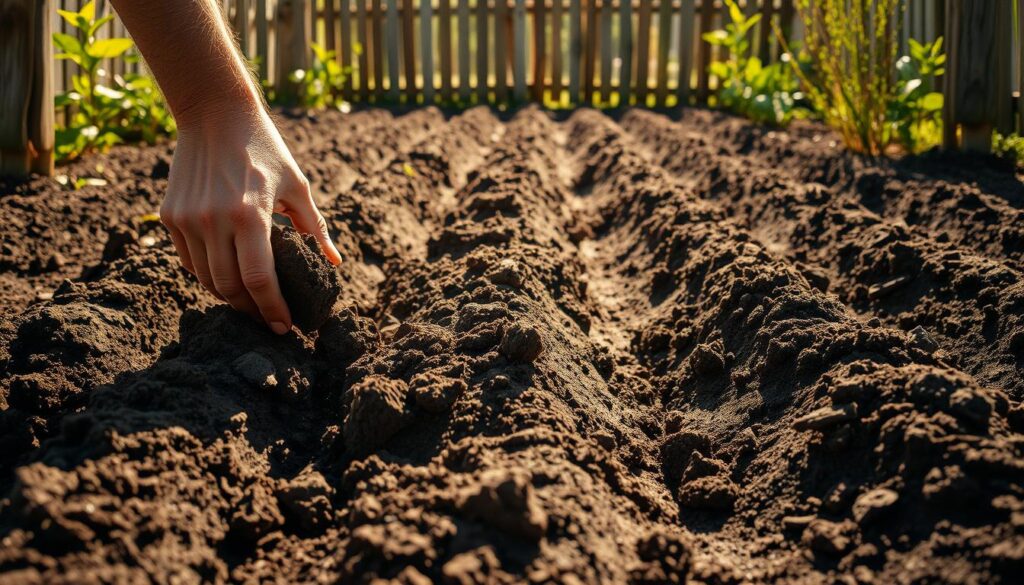
Improve Soil with Mulch and Compost
Healthy soil is the backbone of a thriving garden. Start by testing your soil to determine its type and nutrient levels. For clay-heavy soil, Second Source recommends using bark mulch to improve drainage and texture.
Layer compost using the “lasagna gardening” technique. This method involves alternating organic materials like leaves, grass clippings, and kitchen scraps. Over time, these layers break down, enriching the soil with nutrients. For degraded earth, consider Second Source’s 3-year remediation plan to restore fertility.
Install Irrigation Systems
Efficient water management is crucial for plant health. Drip irrigation systems with smart timers ensure your plants receive consistent moisture without waste. Position hoses carefully to avoid tripping hazards and ensure even coverage.
Raised beds with proper drainage are ideal for veggies. They prevent waterlogging and make it easier to control soil quality. Combine these systems with mulching to retain moisture and reduce the need for frequent watering.
| Preparation Step | Benefit | Tip |
|---|---|---|
| Soil Testing | Identifies nutrient needs | Use RHS methods for accuracy |
| Mulching | Improves soil structure | Apply bark mulch for clay soil |
| Drip Irrigation | Saves water and time | Install smart timers for efficiency |
| Raised Beds | Enhances drainage | Build with proper drainage holes |
By focusing on these steps, you create an environment where your plants can thrive. Proper preparation saves time and effort, ensuring your outdoor space flourishes season after season.
Maintaining Your Garden Plan
Keeping your outdoor space thriving requires consistent care and attention. A well-maintained garden not only looks beautiful but also supports healthy plants and a balanced ecosystem. Regular upkeep ensures your garden evolves gracefully over time.
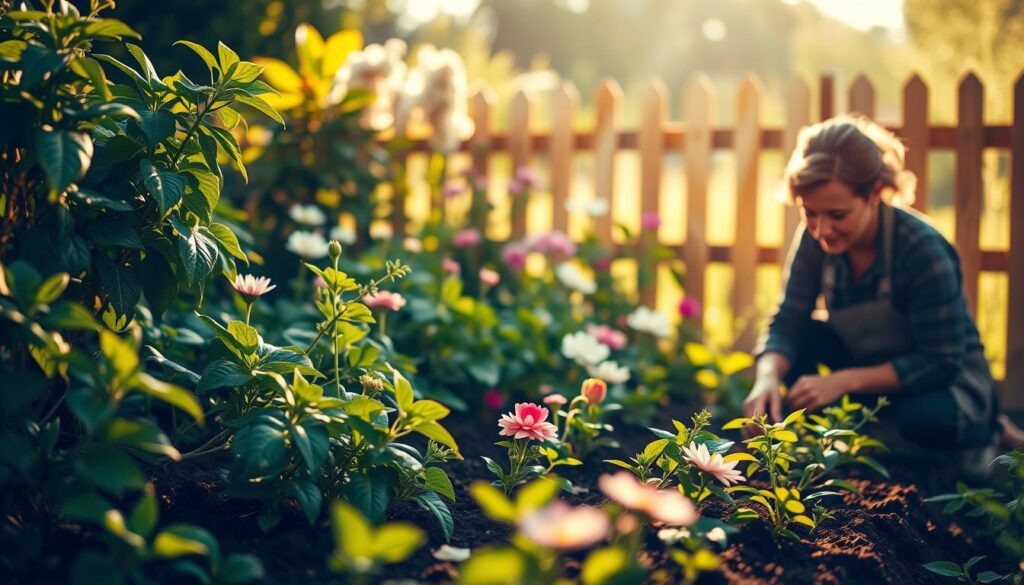
Monitor Plant Health
Regularly checking your plants for pests or diseases is crucial. Use organic treatments like neem oil or companion planting to keep issues at bay. Pruning shrubs during dormancy promotes healthy growth and prevents overcrowding.
Rotating crops annually is another smart strategy. For example, Second Source suggests transforming a veg patch into a play area after a few years. This prevents soil depletion and keeps your garden dynamic.
Adjust Your Plan as Needed
Your garden is a living space that changes over time. Update layouts to accommodate aging trees or expanding families. Keeping a garden journal helps track bloom times and yields, making the process easier.
Seasonal adjustments are also important. For instance, add pollinator-friendly plants in spring or install shade structures for summer. These small changes ensure your garden remains functional and beautiful year-round.
“A well-maintained garden evolves with your needs, offering continuous joy and beauty.”
| Maintenance Task | Benefit | Tip |
|---|---|---|
| Pest Checks | Prevents plant damage | Use organic treatments weekly |
| Pruning | Promotes healthy growth | Trim during dormancy |
| Crop Rotation | Prevents soil depletion | Rotate annually |
| Layout Updates | Adapts to changing needs | Use Second Source’s example |
| Garden Journal | Tracks progress | Record bloom times and yields |
By following these steps, you ensure your garden remains a vibrant and functional space. For more tips on maintaining your outdoor area, visit New Gen Living.
Conclusion
Bringing your outdoor vision to life requires careful planning and creativity. From assessing your space to selecting the right plants, each step ensures your garden thrives. Experimentation is key, but always respect the ecological balance to support local wildlife.
For inspiration, explore Third Source’s 20 unique garden plans. These designs cater to various styles and needs, offering fresh ideas for your outdoor space. Over time, your efforts will reward you with a vibrant edible garden or a sanctuary for pollinators.
Share your progress photos to inspire others. Every design is a step toward creating a sustainable and beautiful outdoor haven. Let your garden be a reflection of your creativity and care.

